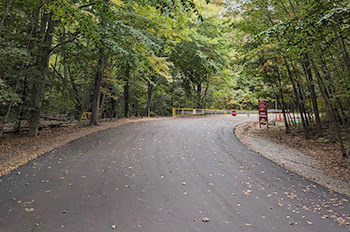Invasive red swamp crayfish found in two locations in Michigan

The Michigan Department of Natural Resources recently confirmed the presence of invasive red swamp crayfish (Procambarus clarkii) in Sunset Lake in Vicksburg, south of Kalamazoo (Kalamazoo County), and in a retention pond off Haggerty Road in Novi (Oakland County).
Reports of the crayfish at Sunset Lake came to the DNR from two separate landowners Thursday, July 13. DNR staff verified the reports during a survey of the area July 14, finding several crayfish in the grass in a local park and in shallow areas on the lake’s west side.
A citizen reported possible red swamp crayfish in the Novi retention pond Monday, July 17, after a child captured one in a dip net. DNR staff responded that afternoon and removed 111 specimens from the pond.
These two reports represent the first live detections of red swamp crayfish in Michigan. In 2015, discovery of a pile of dead red swamp crayfish at Kollen Park in Holland (Allegan County) led to an intensive trapping effort by the DNR in Lake Macatawa and portions of the Grand River. No live crayfish were found at that time.
What are red swamp crayfish?
Red swamp crayfish, also known as Louisiana crayfish, are deep red in color with bright red, raised spots covering the body and claws. They have a black, wedge-shaped stripe on the top of the abdomen. Between 2 and 5 inches in length, these crayfish resemble miniature lobsters. They are native to the Mississippi River drainage and the Gulf Coast and are the popular “crawfish” or “crawdads” used in southern cooking.
Why are they a concern?
Red swamp crayfish are a serious concern because of their ability to damage earthen structures and the threats they pose to the environment.
“Eradicating red swamp crayfish is very difficult,” said Nick Popoff, aquatic species and regulatory affairs manager for the DNR. “They dig deep burrows near lakes and rivers and can spread quickly over land.” Popoff said that such burrows, which can be more than 3 feet deep, can cause damage (through bank destabilization) to infrastructure such as dams, levees, irrigation systems and personal property. In Wisconsin, the only solution for one instance of a red swamp crayfish invasion was an extreme measure to pave over a pond.
Red swamp crayfish are considered invasive in Michigan because they compete aggressively with native crayfish species for food and habitat. They feed on plants, insects, snails, juvenile fish and other crayfish, disrupting the food chain for many aquatic species.
Red swamp crayfish can survive drought conditions and are known to migrate as much as approximately 2 miles over land in search of habitat. They are very fertile, with females laying up to 600 eggs at a time and reproducing up to two times in a year.
How did red swamp crayfish get here?
Sources of the two infestations are not known, but according to Popoff, live crayfish may have been brought from southern states for use as bait or for human consumption. Red swamp crayfish also are sold in some states as personal or classroom aquarium pets, and release of those pets is one way invasive species are spread.
“Red swamp crayfish are a prohibited species in Michigan, which means it is unlawful to possess, introduce, import, sell or offer them for sale as a live organism, except in special circumstances, including providing specimens to the DNR for identification,” said Popoff.
What is being done?
Department staff will continue survey and removal efforts on Sunset Lake and its tributaries to determine the size and extent of the infestation. Staff will be out during the daytime and evening hours setting nets and crayfish traps and using electrofishing equipment to capture and remove the crayfish. Connecting water bodies including Austin, Barton and Howard lakes will be surveyed in the coming weeks. Survey and removal efforts are ongoing at the Novi location.
How can people help?
“These two cases show the importance of citizen involvement in the fight against invasive species,” said Popoff. “Alert citizens noticed something unusual and reported it to the DNR, allowing us to initiate a quick response to each situation.”
Residents and visitors to the Sunset Lake area are asked to try to capture any red swamp crayfish they find and place them in a container in the freezer, then report the location of the find to the DNR at 269-685-6851, ext. 0, or by email to herbsts1@michigan.gov.
Sightings of red swamp crayfish in the Novi area or elsewhere in Michigan should be photographed and reported with the date and location of the find to herbsts1@michigan.gov.
For more information about red swamp crayfish and other invasive species of concern in Michigan, visit www.michigan.gov/invasivespecies.
Contact: Nick Popoff, 517-284-5830, popoffn@michigan.gov or Joanne Foreman, 517-284-5814, foremanj@michigan.gov





